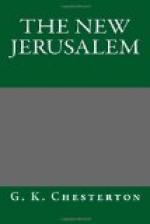Nor do I forget the long centuries that have passed over the place since these medieval walls were built, any more than the far more interesting centuries that passed before they were built. But any one taking exception to the description on that ground may well realise, on consideration, that it is an exception that proves the rule. There is something very negative about Turkish rule; and the best and worst of it is in the word neglect. Everything that lived under the vague empire of Constantinople remained in a state of suspended animation like something frozen rather than decayed, like something sleeping rather than dead. It was a sort of Arabian spell, like that which turned princes and princesses into marble statues in the Arabian Nights. All that part of the history of the place is a kind of sleep; and that of a sleeper who hardly knows if he has slept an hour or a hundred years. When I first found myself in the Jaffa Gate of Jerusalem, my eye happened to fall on something that might be seen anywhere, but which seemed somehow to have a curious significance there. Most people are conscious of some common object which still strikes them as uncommon; as if it were the first fantastic sketch in the sketch-book of nature. I myself can never overcome the sense of something almost unearthly about grass growing upon human buildings. There is in it a wild and even horrible fancy, as if houses could grow hair. When I saw that green hair on the huge stone blocks of the citadel, though I had seen the same thing on any number of ruins, it came to me like an omen or a vision, a curious vision at once of chaos and of sleep. It is said that the grass will not grow where the Turk sets his foot; but it is the other side of the same truth to say that it would grow anywhere but where it ought to grow. And though in this case it was but an accident and a symbol, it was a very true symbol. We talk of the green banner of the Turk having been planted on this or that citadel; and certainly it was so planted with splendid valour and sensational victory. But this is the green banner that he plants on all his high cities in the end.
Therefore my immediate impression of the walls and gates was not contradicted by my consciousness of what came before and what came after that medieval period. It remained primarily a thing of walls and gates; a thing which the modern world does not perhaps understand so well as the medieval world. There is involved in it all that idea of definition which those who do not like it are fond of describing as dogma. A wall is like rule; and the gates are like the exceptions that prove the rule. The man making it has to decide where his rule will run and where his exception shall stand. He cannot have a city that is all gates any more than a house that is all windows; nor is it possible to have a law that consists entirely of liberties. The ancient races and religions that contended for this city agreed with each other in this, when they differed about everything else. It was true of practically all of them that when they built a city they built a citadel. That is, whatever strange thing they may have made, they regarded it as something to be defined and to be defended.




